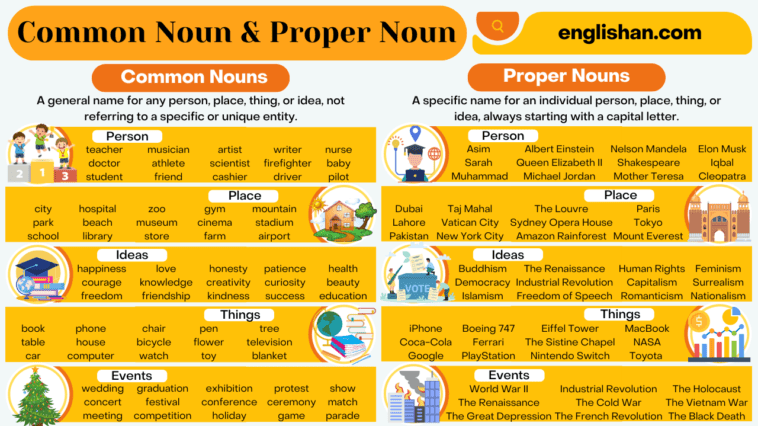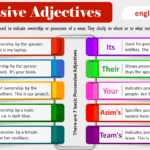Nouns are essential components of the English language, serving as labels for people, places, things, and ideas. Among the various types of nouns, common nouns, and proper nouns hold significant importance. Common nouns refer to general or non-specific items, places, or people, such as “book,” “tree,” or “person.” In contrast, proper nouns refer to specific and unique entities, such as “Harvard University,” “Paris,” or “Maria.” Understanding common noun and proper noun is crucial for effective communication. In this article, we will explore the basics of common and proper nouns with examples. So, let’s get started!
What Is a Common Noun?
A common noun is a basic word that names general things, people, places, or ideas. It’s not specific to any particular individual or item but represents a group. Common nouns are everyday words like “teacher,” “city,” “book,” or “happiness.” They’re the common, ordinary names we use in daily life. Importantly, common nouns are written in regular lowercase letters unless they start a sentence. For example, when we say “cat,” we’re talking about any cat, not a specific one. “City” refers to any city, not a particular one like New York or Paris. Similarly, “book” is a common noun, representing any book rather than a specific title.
Examples:
- Person: teacher, student, friend
- Place: school, park, city
- Thing: book, car, table
- Idea: happiness, freedom, love
What Is a Proper Noun?
A proper noun is a specific name for a particular person, place, thing, or idea. Unlike common nouns, proper nouns always start with a capital letter. They highlight the individuality of something and help us identify it uniquely. They help us identify unique entities, like individual names (Sarah), specific places (Paris), particular things (Eiffel Tower), or distinct ideas (Renaissance). Capitalization distinguishes them from common nouns, which refer to general categories. For instance, while “teacher” is a common noun, “Mrs. Johnson” is a proper noun because it refers to a specific teacher.
Examples:
- Person: Sarah, Asim, Einstein
- Place: Paris, Mount Everest, Taj Mahal
- Thing: Coca-Cola, iPhone, Eiffel Tower
- Idea: Buddhism, Democracy, Renaissance
Common Noun and Proper Noun Rules
Common nouns and proper nouns are types of nouns that help us name people, places, things, and ideas. Let’s understand the rules for each:
Common Noun Rules
Common nouns are words that refer to general, everyday things and are not specific to particular individuals. Here are some basic rules:
- Naming Ordinary Things: Common nouns are used to name ordinary, everyday items, like “table,” “chair,” or “book.”
- No Specific Names: They don’t refer to a particular person, place, or thing. For example, “city” is a common noun, but “New York” is a proper noun.
- No Capitalization: In most cases, common nouns do not start with a capital letter unless they begin a sentence.
- Refer to General Things: They represent general things rather than specific ones. For instance, “dog” is a common noun, while “Buddy” (a specific dog’s name) is a proper noun.
- Can Be Countable or Uncountable: Common nouns can be either countable (like “table” or “book”) or uncountable (like “water” or “love”).
- No Ownership: They do not indicate ownership. Use a possessive form or proper noun for ownership, like “Sarah’s book” or “the company’s success.”
- Can Have Plural Forms: Common nouns can have plural forms to indicate more than one, such as “cats” or “houses.”
- Used with Articles: They are often used with articles like “a,” “an,” or “the” to show if something is specific or not. For instance: a cat, an apple, the car
Proper Noun Rules
Proper nouns are specific names given to particular people, places, or things. Here are some basic rules to remember:
- Capitalization: Always capitalize the first letter of a proper noun. For example: John, Paris, Coca-Cola
- Individual Names: Proper nouns refer to individual and unique entities. Use them for specific people, cities, companies, etc. For example: Sarah, London, Google
- Geographical Names: Names of countries, cities, rivers, and mountains are proper nouns. For example: Brazil, Nile River, Mount Everest
- Brands and Companies: Specific brand names and company names are proper nouns. For example: Apple, Microsoft, Toyota
- Days, Months, and Holidays: Days of the week, months, and holidays are proper nouns. For example: Monday, December, Thanksgiving
- Historical Events: Specific historical events and periods are proper nouns. For example: World War II, Renaissance
- Religious Terms: Names of religious figures and texts are proper nouns. For example: Jesus, Bible, Quran
- Titles and Initials: Capitalize titles and initials that are part of a person’s name. For example, Dr. Smith, and J.K. Rowling.
- Specific Buildings or Monuments: Capitalize the names of specific buildings or monuments, such as the Eiffel Tower or the White House.
- Religions and Nationalities: Proper nouns are used for names of religions and nationalities. For example: Christianity, Muslims, and Pakistanis.
List of Common Nouns
- cat
- dog
- book
- teacher
- computer
- city
- car
- tree
- table
- chair
- student
- phone
- river
- house
- ball
- flower
- friend
- school
- pencil
- ocean
- bird
- game
- family
- job
- country
- language
- idea
- problem
- food
- air
- water
- bed
- shoe
- hat
- shirt
- door
- window
- street
- bicycle
- cup
- knife
- paper
- pen
- wallet
List of Proper Nouns
- Paris
- London
- New York City
- Tokyo
- Sydney
- Amazon
- Coca-Cola
- Muslims
- Christianity
- Islam
- McDonald’s
- Quaid-e-Azam
- Mona Lisa
- Shakespeare
- Michael Jackson
- Mount Everest
- Amazon River
- Pacific Ocean
- Statue of Liberty
- Eiffel Tower
- Taj Mahal
- Abraham Lincoln
- Queen Elizabeth II
- NASA
- Disneyland
- Batman
- Superman
- Spider-Man
- The White House
- Great Wall of China
- Nelson Mandela
- Albert Einstein
- Marie Curie
- World War I
- World War II
- Holocaust
- Vietnam War
- Korean War
- Renaissance
- Great Depression
- Industrial Revolution
- Cold War
- French Revolution
- Apollo 11 Moon Landing
Example Sentences
- I need to buy a new car.
- The teacher is explaining the lesson.
- Can you pass me the salt?
- The computer is not working properly.
- The sun sets in the west.
- My friend works at Google.
- We visited the Eiffel Tower in Paris.
- My favorite color is blue.
- The table is made of wood.
- Happiness is a choice.
- She has a collection of rare coins.
- The telephone is ringing.
- Can you hand me a pen?
- I read a poem by Emily Dickinson.
- The mountain is covered in snow.
- Time flies when you’re having fun.
- I need a new pair of shoes.
- The moon shines brightly at night.
- Harry Potter is a famous wizard.
- NASA sent astronauts to the moon in 1969.
- My favorite author is J.K. Rowling.
- I’m reading a book by Shakespeare.
- We visited the White House in Washington, D.C.
- Albert Einstein was a brilliant scientist.
- I visited the Great Wall of China last year.
FAQs
Q1: What is a common noun?
A common noun is a general name for a person, place, thing, or idea. It doesn’t specify a particular individual or entity. Examples include “city,” “book,” and “teacher.”
Q2: What is a proper noun?
A proper noun is a specific name for a particular person, place, thing, or idea. It always begins with a capital letter. Examples include “Paris,” “Mary,” and “Coca-Cola.”
Q3: How do you differentiate between common and proper nouns in a sentence?
Common nouns are general and not capitalized, while proper nouns are specific and always begin with a capital letter. For example, “dog” is a common noun, but “Max” (a specific dog’s name) is a proper noun.
Q4: Can common nouns become proper nouns?
Yes, common nouns can become proper nouns when they are used as specific names. For instance, “teacher” is a common noun, but if we say “Ms. Johnson” (a specific teacher), it becomes a proper noun.
Q4: Give example sentences of common and proper nouns.
Here are example sentences of common nouns and proper nouns:.
- The girl is playing in the park.
- I bought a new car yesterday.
- The office is closed on weekends.
- We visited the Eiffel Tower in Paris.
- I read a poem by Emily Dickinson.
You May Also Like:
- Types of Adjectives
- Pronouns with Examples
- Adjectival Phrases
- Possessive Adjectives in English with Examples
- Types of Prepositions



